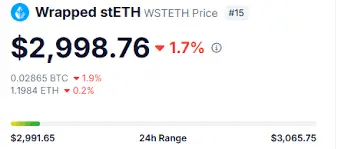Wrapped stETH Staking Rewards: DeFi Integration & Yield Farming Strategies
Wrapped stETH (wstETH) is a non-rebasing version of Lido Finance's stETH (staked Ethereum) token, designed to provide better compatibility with DeFi protocols. Unlike stETH, which automatically adjusts its balance daily based on staking rewards, wstETH maintains a constant balance while the underlying value appreciates through an increasing exchange rate.
Fundamental Data
Founding Team:
The Lido protocol was founded by experienced blockchain developers, including Jordan Fish, Vasiliy Shapovalov, and Konstantin Lomashuk. The team raised $2 million in December 2020 from notable investors, including Semantic Ventures, ParaFi Capital, and prominent figures like Rune Christensen (MakerDAO), Stani Kulechov (Aave), and Kain Warwick (Synthetix).
Use Case:
wstETH serves as a wrapped version of stETH that solves compatibility issues with DeFi protocols.
Participate in DeFi applications while earning staking rewards
- Maintain a stable token balance for easier integration
- Use as collateral in lending protocols like Aave and MakerDAO
- Provide liquidity on decentralized exchanges
Tokenomics:
- Mechanism: wstETH is minted when stETH is wrapped and burned when the exchange rate between wstETH and stETH increases over time as staking rewards accrue.
- No Maximum Supply: Unlimited supply based on underlying stETH deposits.
How to Integrate wstETH in dApps
For Developers:
- Implement proper Oracle integration for accurate pricing
- Understand the non-rebasing mechanism - balance stays constant while value appreciates.
- Consider liquidity and de-peg risks when setting parameters.
- Reference existing integrations like Aave and MakerDAO for the best.
Wrapped stETH (wstETH) represents a revolutionary approach to cryptocurrency liquid staking, solving critical compatibility issues between rebasing tokens and DeFi protocols. As an expert analysis from ClipsTrust's cryptocurrency team, this comprehensive review covers everything you need to know about this innovative token.
Understanding what is cryptocurrency mechanics behind wstETH requires knowledge of liquid staking derivatives. Unlike traditional stETH that automatically adjusts balances daily, wstETH maintains constant token quantities while value appreciation occurs through exchange rate increases.
Key Features and Benefits
Liquidity Provision: wstETH enables users to earn staking rewards while maintaining token liquidity for trading, lending, and yield farming activities across top crypto exchanges in India.
DeFi Compatibility: The non-rebasing nature makes wstETH ideal for integration with major protocols like Aave, Compound, Curve, and Uniswap, addressing limitations faced by traditional rebasing tokens.
Staking Efficiency: Users can participate in Ethereum 2.0 staking without meeting the 32 ETH minimum requirement or managing validator infrastructure.
Market Performance Analysis
Current market data shows wstETH maintaining strong fundamentals with over $15 billion market capitalization and ranking among top cryptocurrency assets. The token demonstrates consistent trading volume across decentralized exchanges, particularly on Uniswap V3 and Balancer V2.
Price performance reflects underlying ETH staking rewards plus DeFi utility premium, making it attractive for both passive staking and active trading strategies. Historical data indicates strong correlation with ETH price movements while providing additional yield through staking rewards.
Trading and Investment Strategies
Conservative Approach: Hold wstETH for passive staking rewards while maintaining liquidity options for market opportunities.
Active Trading: Utilize wstETH in leverage strategies, arbitrage opportunities, and liquidity provision across multiple DeFi protocols.
Yield Farming: Combine staking rewards with additional yields from lending protocols, creating enhanced return opportunities.
Risk Considerations
Smart Contract Risk: Despite extensive auditing, smart contract vulnerabilities represent inherent risks in DeFi protocols.
Slashing Risk: Underlying staked ETH faces potential slashing penalties, though Lido's diversified validator network minimizes this exposure.
Liquidity Risk: Market conditions may cause temporary de-pegging from the underlying ETH value, creating arbitrage opportunities or losses.
Regulatory Environment
Considering the cryptocurrency legal regulations in India, wstETH operates within established legal frameworks for digital assets. Users should understand local compliance requirements and tax implications for staking rewards and trading activities.
The token's design as a wrapped derivative follows established patterns recognized by financial regulators, though specific guidance continues evolving across jurisdictions.
Technical Integration Guide
Developers integrating wstETH should understand its non-rebasing mechanics and implement proper oracle systems for accurate pricing. The ERC-20 standard ensures compatibility with existing wallet infrastructure and DeFi protocols.
Smart contract interactions require an understanding of the wrap/unwrap mechanism and exchange rate calculations for proper value accounting in applications.
Future Development Roadmap
Lido V3 introduces stVaults technology, enabling customized staking configurations and enhanced institutional features. Dual governance implementation provides stETH holders with voting rights alongside LDO token holders.
Cross-chain expansion continues with deployments across Layer 2 solutions and alternative blockchain networks, increasing utility and accessibility.
Community and Governance
The Lido DAO governs protocol development through community voting mechanisms. Recent proposals focus on decentralization improvements, risk management enhancements, and ecosystem growth initiatives.
Active community engagement through Discord, governance forums, and regular development updates maintains transparency and collective decision-making processes.
Expert ClipsTrust Analysis
Our cryptocurrency experts evaluate wstETH as a mature DeFi primitive with strong fundamentals and growing ecosystem adoption. The combination of staking yields, DeFi utility, and institutional integration creates compelling value propositions for various investor profiles.
Technical architecture demonstrates robust design principles with extensive auditing and battle-tested smart contracts. However, users should understand inherent risks and maintain proper risk management practices.
Mining and Validation
Understanding what is cryptocurrency mining helps contextualize wstETH's role in Ethereum's transition to Proof-of-Stake consensus. Rather than traditional mining, wstETH represents participation in validator networks through liquid staking mechanisms.
This approach democratizes access to staking rewards while maintaining network security through professional validator operations managed by Lido's curated operator network.
ClipsTrust Reviews and Ratings
Based on our comprehensive analysis, ClipsTrust rates wstETH highly for its technical innovation, market adoption, and ecosystem utility. Users should conduct independent research and consider personal risk tolerance before investing.
We encourage community members to share their experiences and provide feedback on wstETH performance, helping future users make informed decisions about liquid staking opportunities.
Frequently Asked Questions
Q1: What is the difference between stETH and wstETH?
wstETH is a rebasing token that automatically adjusts balance daily based on staking rewards, while wstETH maintains a constant balance with value appreciation occurring through exchange rate increases, making it more suitable for DeFi applications.
Q2: How do I earn rewards with wstETH?
wstETH automatically accrues staking rewards through its underlying stETH representation. Additionally, users can earn extra yields by using wstETH in DeFi protocols like Aave for lending or Curve for liquidity provision.
Q3: Is wstETH safe to use in DeFi protocols?
wstETH has undergone extensive security audits and is widely integrated across major DeFi platforms. However, users should understand smart contract risks, slashing penalties, and potential de-pegging scenarios before participating.
Q4: Can I unstake wstETH back to ETH?
Yes, wstETH can be unwrapped to stETH and then withdrawn to ETH through Lido's withdrawal mechanism. The process may involve waiting periods depending on validator exit queues and protocol conditions.
Q5: What are the tax implications of holding wstETH?
Tax treatment varies by jurisdiction, but generally staking rewards may be considered taxable income. Users should consult tax professionals familiar with cryptocurrency regulations in their location for specific guidance.
Explore trusted business video and authentic reviews on the Official ClipsTrust YouTube channel and Connect with us on our socials:
Follow us on Social media Facebook, Instagram, LinkedIn and Twitter.
Get to know more about such information and list your business on ClipsTrust.








